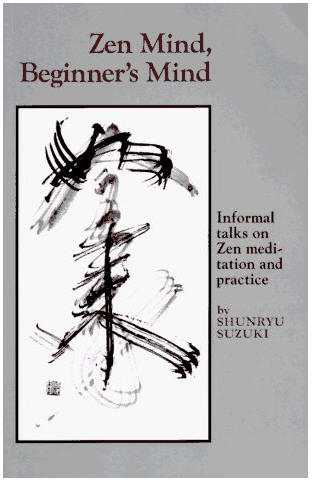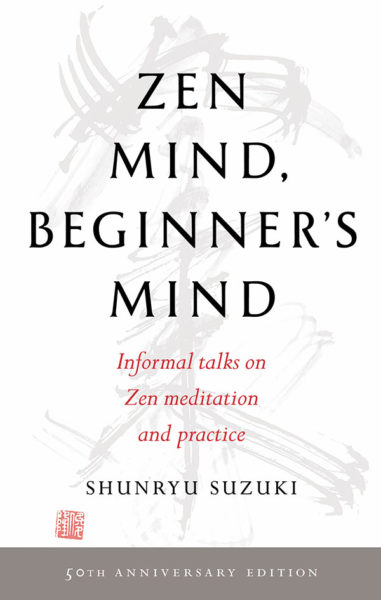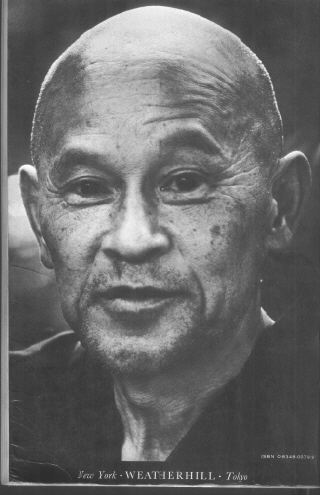Zen Mind, Beginner's Mind
Informal Talks on Zen Meditation and Practice

Cover from the original edition, published by Weatherhill, 1970. The famous first book of Suzuki's lectures. Now published by Shambhala in various forms under the Shambhala and Weatherhill names (Shambhala bought Weatherhill).

ZMBM at 50 (annotated) for the 50th Anniversary Issue of ZMBM to be published in 2020 - with updates and corrections to the Afterword for the 40th.

The back cover of ZMBM, photo by Robert S. Boni
On the Rise of Beginner’s Mind 🔊 - Podcast, July 2025
this was an extemporaneous podcast, pretty poor. I want to replace it. Best just to read what's below which is way tighter. - dc
The Spread of Beginner’s Mind
In October 1965 during a sesshin lecture, Shunryu Suzuki, in the earliest instance on record, mentioned beginner’s mind. From the verbatim transcript:
So Dogen Zenji always emphasized beginner's mind. We should always remain in beginner's mind. It means our experience should always be refreshed and renewed. It means always have the joy of discovering something. The same joy as children discovering something new. This kind of experience is not possible to attain just by training through which you expect some result.
On November 11, 1965, Suzuki gave a brief talk about the importance of beginner’s mind at the Los Altos Zen Center in Marian Derby’s living room. She recorded the lecture. Two excerpts:
Shoshin means beginner’s mind. If we can keep beginner’s mind always, that is the goal of our practice.
In beginner’s mind we have many possibilities, but in expert mind there is not much possibilities.
Suzuki said his master Gyokujo So’on would admonish him not to lose beginner’s mind. He occasionally would return to the theme of beginner’s mind in lectures, but not often. Outside of the beginner’s mind lecture, the phrase only comes up ten times in the 452 lectures that survive.
Suzuki attributed the phrase to Soto Zen’s founder, Dogen. Though Dogen’s writings are full of the spirit of shoshin, he apparently rarely used the term and when he did it was in a more conventional limited way. Same if we look back at mentions of the concept in earlier Chinese and Indian sources. Suzuki spoke of beginner’s mind as essential to Zen practice, never to be left behind. "If you can keep your beginner's mind forever, you are Buddha.” I assume that Suzuki saw much of Dogen’s teaching as having the spirit of beginner’s mind without explicitly using shoshin. In English he said it was the same as original mind, inmost mind, and way-seeking mind.
In the spring of 1967, Marian Derby showed Suzuki a draft for a book of his lectures given in Los Altos that she entitled Beginner’s Mind. Suzuki asked her to show it to Richard Baker. Baker asked Trudy Dixon to edit the lectures further.
In 1968 Baker, newly arrived in Japan, showed the manuscript which he’d worked on further, to Meredith Wetherby whose Wetherhill published the book as Zen Mind, Beginner’s Mind. in 1970 with the edited from the original and often quoted, “In the beginner’s mind there are many possibilities, but in the expert’s mind there are few.”
In 1970, Shambhala published Ed Brown’s Tassajara Bread Book.
In 1971 Be Here Now by Ram Dass was published by Lama Foundation with a section on Tassajara in it.
All three books became best-sellers translated into dozens of languages and more students came to Zen Center as a result of each.
In 1972 Steve Jobs went to Reed College. He and his friend Daniel Kottke devour spiritual books, Zen Mind, Beginner’s Mind and Be Here Now being Jobs’ favorites according to Kottke.
In April 1974 Jobs and Kottke went to India seeking enlightenment. Jobs returned disillusioned to his home and work with Atari in November.
In 1975 Jobs started sitting in Los Altos at the Haiku Zendo, named that since the garage was turned into a zendo with 17 seats in 1966. It’s the same house where Suzuki gave the Zen Mind, Beginner’s Mind lectures. Marian Derby has moved on. Les Kaye, an IBM employee ordained as a priest by Shunryu Suzuki, lived there with his family.
Jobs developed a close relationship with Kobun Chino, the abbot of the Los Altos Zen Center, and met with Les Kaye as well to discuss Zen practice and work.
In 1977 Les Kaye’s Zen at Work was published by Three Rivers Press.
In 1998, Les Kaye initiated Apple's Zen Attitude meditation program—an informal but influential employee group focused on Zen practice and mindfulness. Les continued to meet with Jobs. He created a Zen at Work type program with Apple as his most consistent client.
Jobs spoke of "the lightness of being a beginner again" when he returned to Apple in 1998. This period marked not just the beginning of Apple's most innovative phase, but when the acceleration of use of beginner's mind on a wider stage became most pronounced.
In my Afterword to the 50th anniversary Issue of Zen Mind, Beginner’s Mind (www.cuke.com/zmbm/zmbm_at_50-notes.html), I mention a number of anecdotal instances highlighting the lasting and deep popularity of the book such as director Sam Pekinpah keeping a copy by his bed, basketball coach Phil Jackson referring to it often in his book Sacred Hoops, and former Apple intern Marc Benioff, billionaire CEO of Salesforce and owner of Time magazine saying he lives with beginner's mind.
For the purposes of this report, I did a more statistical search calling on ChatGPT and Claude-AI to help with analysis.
Google Books reveals beginner's mind usage rising gradually from 1970, a little more through the 1990s, then increasing at a 70-degree angle on a graph after 2000, a rise that continued to 2021, the last year for their data which showed one instance of beginner’s mind every 177,000,000 words.
This acceleration coincides with the dot-com boom and emphasis on innovation, Jobs' return to Apple, as well as growing interest in mindfulness in business contexts such as Fortune 500 leadership development programs and coaching platforms like BetterUp specifically targeting beginner's mind cultivation.
A search in Google Scholar came up with 4,960 mentions of beginner’s mind across multiple disciplines. A much smaller yet impressive number was it showing up in 339 peer reviewed articles in the JSTOR database.
Some examples of the use of beginner’s mind I came upon.
A medical journal application: “The concept of beginner’s mind invites the expert medical professional to be present to their patients, remaining curious and responsive.” National Library of Medicine
In teaching: “The beginner’s mind has a simple vocabulary founded upon questioning and the willingness to learn… bringing one simple question into each moment: ‘What is this?’” Taylor & Francis Online
Business and design writing: “Beginner’s mind shelves all preconceptions… looks at the problem with a fresh perspective.” (Jason Wang, UX design context) Medium
From mindfulness media: A “30-Minute Video Meditation to Approach Life With Beginner's Mind: Explore a childlike wonder as you drift off to sleep.” Wikipedia
Sociological viewpoint: “A ‘sociological beginner’s mind’ is willing, able, and genuinely excited to see the complexity and chaos of everyday life.” Everyday Sociology Blog
IDEO describes adopting a “beginner's mind” in their design thinking approach, with the intent to remain open and curious, to assume nothing, and to see ambiguity as an opportunity, which they applied in their shopping cart redesign project documented at designthinking.ideo.com.
Jason Wang illustrates the power of beginner’s mind in design by reflecting on his surprise at fortune cookies and takeout boxes in American Chinese food culture: medium.com/salesforce-ux/beginner-s-mind-62a28d144a5c
Teaching with the Beginner's Mind: Notes from My Karate Journal
by Sheryl I. Fontaine
The phrase “promiscuous pairing and beginner's mind” comes from Arlo Belshee's 2005 research paper that describes how agile programming teams can achieve high-efficiency by constantly switching pair programming partners and maintaining a beginner's mindset that depends on instability rather than flow states, available at ieeexplore.ieee.org/document/1609811.
I was looking into the extent of the name recognition and reputation of Shunryu Suzuki. I used Google searches and AI. I soon found Suzuki’s name associated with beginner’s mind far more than anything else. I found that beginner’s mind was far more well-known than Shunryu Suzuki. It appears that a few million people might know who Suzuki was, but beginner’s mind way more. I hesitate to state a number because it’s hard to believe what we were coming up with. Anyway, a lot.
Claude characterized beginner's mind as “the most successful example of cross-cultural concept transfer in modern times.” Maybe so. For sure the concept transcended its religious origins to become a secular methodology applicable across disciplines. And it’s still applied by countless Buddhists and others in their spiritual practice. I’ll be checking up on these results in various ways, especially some of the details. But this is what I’ve got for now.
Shunryu Suzuki likened establishing Buddhism in America to holding a plant next to a rock and waiting for it to take root. Suzuki’s Beginner’s Mind talk in Marian Derby’s Los Altos living room was a seed he planted that took hold on our rock--thanks to those mentioned herein, and a cast of uncountable others.
Andrew Main on the font of ZMBM.
As an Amazon Associate Cuke Archives earns from qualifying purchases.